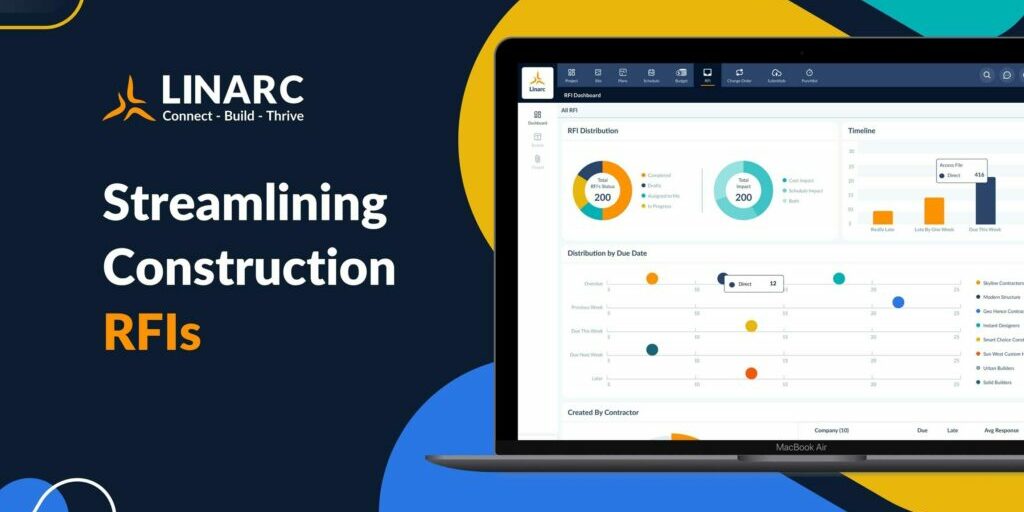Streamlining Construction RFIs

This article covers:
- How to Optimize Project Communication through Effective Construction RFI Management
- What is a construction RFI?
- The Evolution of the Construction RFI Process
- How Does a Construction RFI Work?
- What are the main parts of a construction RFI?
- Pitfalls of the Construction RFI Process
- How do construction management systems streamline RFIs?
- Is your construction RFI process slowing you down?
How to Optimize Project Communication through Effective Construction RFI Management
Construction RFIs are pivotal for project communication, empowering stakeholders to seek clarity and make well-informed decisions. However, mismanagement can lead to delays, increased costs, conflict, and confusion.
This article delves into best practices for construction RFI management, aiming to enhance the overall process, foster effective communication, and ensure prompt RFI responses.
What is a construction RFI?
A construction RFI, short for construction Request for Information, is a formal document that stakeholders use to seek clarification during various project phases.
RFIs occasionally arise during the bidding phase but are most common during the build and will accumulate throughout the duration of the project. They present project delivery teams with an opportunity to enhance project value by identifying avenues to reduce costs, improve efficiency.
Ultimately, RFIs become part of the project documentation and sometimes result in changes to the contract documents, particularly the design drawings, plan sheets, and specifications. The resulting directives, design changes, or changes to the project scope can extend the cost and duration of the project, so it’s important to follow the strict guidelines put in place to submit and respond to RFIs in construction.
The Evolution of the Construction RFI Process
In the past, RFIs were handwritten or phoned into offices. Since typical large-scale projects can generate hundreds of RFIs, you can imagine how disjointed, confusing, and extended that process was and how many delays it caused.
Today, construction software provides templates and automated workflows for efficient RFI management. But just because construction technology makes it easier to create RFIs, the request for information process still must be clearly defined and closely monitored.
How Does a Construction RFI Work?
A poorly handled process will quickly overwhelm an already busy team creating unnecessary delays. Be sure to create an official and formal request system with a clearly outlined process to avoid missteps with potentially serious consequences.
While each process will be specific to your company, here is a basic outline of a typical construction RFI process:
Step 1: Identify the Need to Submit RFI
When issues arise on a work site, it’s important for subcontractors, specialty contractors, and onsite work teams to know when to escalate it to an RFI. The site superintendent or project manager will evaluate the situation, confirm all details of the issue onsite, and make the determination of whether or not an RFI is needed.
Step 2: Submit the RFI to the Appropriate Stakeholder
General contractors and project managers will respond to an official RFI when possible. If they are unable to respond appropriately, it will be escalated to the general contractor’s office or project manager, and then on to the relevant department or individual, as necessary.
Step 3: Process and Document the Response
It is essential to have an adequate process and system in place to record and log RFIs. A digital platform is best to ensure accuracy and can leverage automation to ensure that submitted details and responses are sent, noted, and validated.
Key questions to consider when reviewing an RFI in construction:
- Is there enough information to respond?
- Does the RFI require an onsite visit?
- What other parties are required to respond.
Robust information and communication platforms such as Linarc provide instant access to every stakeholder on the project. With effective communication channels like mobile apps, you can contact key stakeholders onsite and remotely.
Once everyone has contributed, it’s important to document and record all responses and results, detailing a clear line of communication.
Step 4: Enact Response and Return to Work
All RFI responses should be standardized to avoid confusion and ensure that project stakeholders receive–and understand–the information provided and can quickly resolve the RFI issue. Utilizing an established plan ensures that information tracking is accurate and response times are fast.
Once the submitting party receives the RFI response back, they can apply it to the RFI issue and work can continue as scheduled, with fewer interruptions.
What are the main parts of a construction RFI?
Whether using premade templates or creating custom RFIs, it’s crucial to know what to include in a construction RFI and the right way to convey the information.
1. Who are the Key Stakeholders?
Any stakeholder can generate an RFI, but it must be clear who is requesting the information and who should respond. RFIs can involve subcontractors, contractors and project managers, designers, and architects, depending on the issue’s complexity. Typically these requests will come from supervisors, superintendents, subcontractors, and project managers.
The most common stakeholders to respond to an RFI are the general contractor, architect, engineering team, owner, or developer, but suppliers are also frequently included in the RFI process.
2. What is the Timeline for the Request for Information?
The RFI process, from submission to response, may take one to several weeks, although most RFIs resolve within 10-15 business days. Therefore, creating response deadlines and having a robust submitting and response system is essential.An RFI should be dated and have a requested reply date.
But don’t allow your stakeholders to create a sense of urgency without good reason. The best way to accomplish realistic response request dates is to connect the information request with a task, group, or milestone on the project schedule.
That way, respondents have the information to prioritize the many RFIs streaming into their office intelligently.
3. How do you Clearly Identify the RFI According to Protocol?
Because stakeholders are busy working on multiple projects, it’s crucial to identify the project in question. Every project has an identifier, often a serial number or project number that should be used, followed by a unique identifier for your specific RFI. Typically, construction RFIs are sequentially numbered for easy tracking and retrieval and may include a letter code to identify which section the request refers to or who should respond.
Additionally, the RFI needs to specify where on the project the question originates.
Attaching spec sheets, plan sheets, drawings, photographs, and videos is enormously helpful, and technology makes this easy.
4. How do you Write a Clear, Direct Construction RFI?
RFIs should be limited to only one question or issue, be clear and concise, and provide as much relevant detail as possible about that specific question.
Complicating a request for information with multiple questions, issues, opinions, or complaints will only result in rejection and a request for re-clarification. If an RFI is rejected for insufficient information, it creates an added volley of back-and-forth communication.
5. How is the Request for Information Relevant to the Project?
The RFI requestor should never assume the respondent will intuitively understand the relevance of the issue for which they are requesting information.
For that reason, it’s also crucial to include how the issue will impact the schedule or if it’s likely to result in additional costs.
Note: An RFI is not a channel to submit change orders or change requests.
- Stakeholder Information: Identify company name and point of contact for the person that will be handling all the specifics for the construction RFI.
- Purpose of the Request: Outline what needs to be addressed; design, technical, supply?
- Relevant Details: Provide as much information as possible as the data will assist with the decision-making process and speed up responses. Should include pictures, drawings, and onsite observations.
- Resolution Suggestions: If you have ideas about how the request could be addressed, share the details in the construction RFI.
Pitfalls of the Construction RFI Process
Failure to adhere to the construction RFI process can result in significant delays. Mismanagement and disorganization may exacerbate issues rather than resolving them.
The following are key pitfalls to avoid when creating and enforcing your construction RFI process:
- Incorrect Information: Wrong pictures or complex language can lead to delays. RFIs should be concise, containing only relevant information for efficient processing.
- No Dedicated RFI Channel: Without a dedicated communication channel, details get lost. Construction management systems help streamline communication.
- Lack of Specificity: For larger projects, appoint a dedicated RFI manager or response team to ensure accountability for both RFI submissions and responses.
- Misuse of RFI Channels: Unrelated or routine communications clutter the channel. Enforce minimum standards for RFI submissions to maintain clarity and focus.
- No Response Deadlines: Without set dates for response, RFIs may be overlooked. Implement response timelines to create urgency and ensure timely submissions.
- Manual Follow-Ups: Projects with a high volume of RFIs can be overwhelming. Automation aids in active tracking, submission, and faster response generation.
How do construction management systems streamline RFIs?
Construction software significantly improves project efficiency and the flow of work through digital tools designed specifically for the way construction projects are managed and progress. For example, construction management systems provide improved communication on the job site. They speed up the communication process, create a log of communication data, and streamline how information is used. The system enables you to create templates to respond to RFIs and leverage file-sharing systems, with searchable topics, that keep all communications in one place.
Is your construction RFI process slowing you down?
Linarc is a cloud-based construction project management system built solely for collaborative, data-driven construction management.
- Seamless collaboration
- Easy file sharing
- Common communication platform
- Real-time updates on project progress
- …and so much more
Connect with a Linarc representative and see what the power of software technology can do to improve the productivity of your operation.





